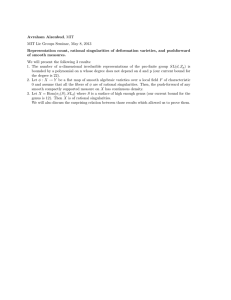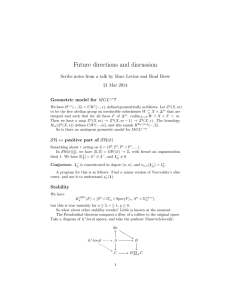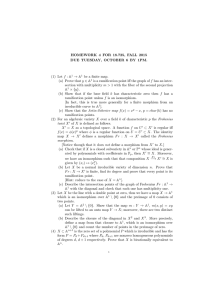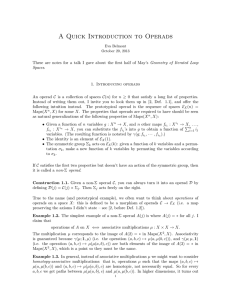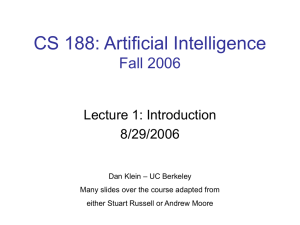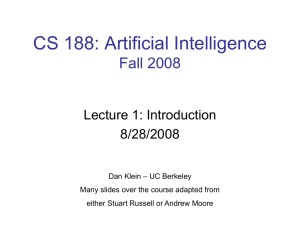Rationally connected varieties over local fields
advertisement
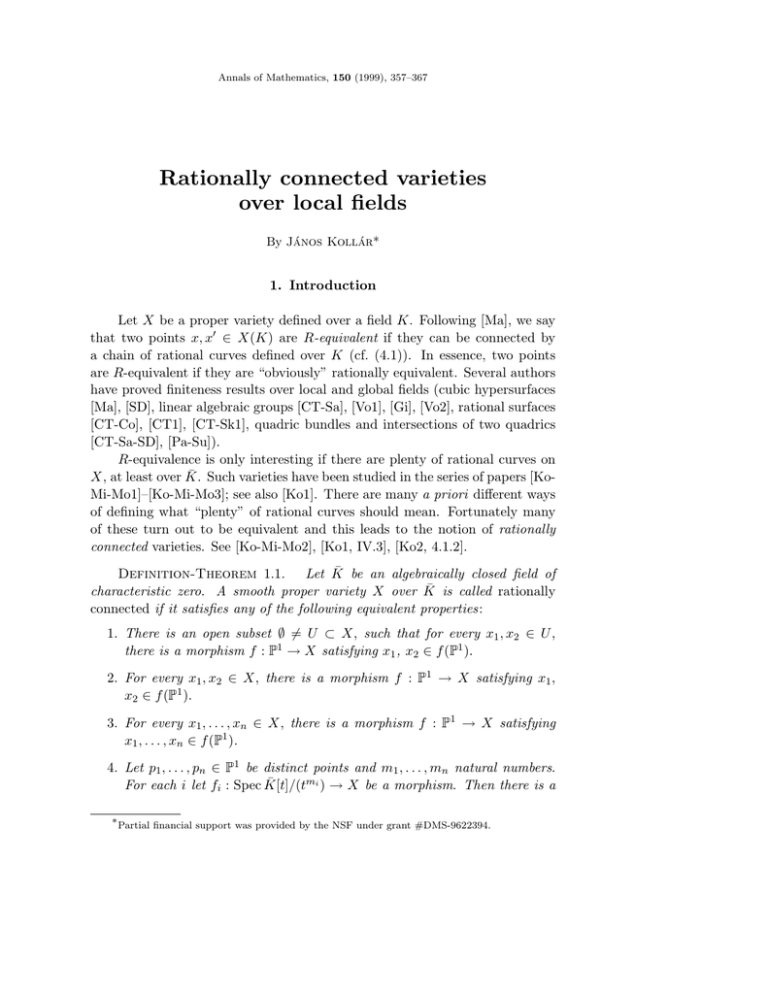
Annals of Mathematics, 150 (1999), 357–367
Rationally connected varieties
over local fields
By János Kollár*
1. Introduction
Let X be a proper variety defined over a field K. Following [Ma], we say
that two points x, x0 ∈ X(K) are R-equivalent if they can be connected by
a chain of rational curves defined over K (cf. (4.1)). In essence, two points
are R-equivalent if they are “obviously” rationally equivalent. Several authors
have proved finiteness results over local and global fields (cubic hypersurfaces
[Ma], [SD], linear algebraic groups [CT-Sa], [Vo1], [Gi], [Vo2], rational surfaces
[CT-Co], [CT1], [CT-Sk1], quadric bundles and intersections of two quadrics
[CT-Sa-SD], [Pa-Su]).
R-equivalence is only interesting if there are plenty of rational curves on
X, at least over K̄. Such varieties have been studied in the series of papers [KoMi-Mo1]–[Ko-Mi-Mo3]; see also [Ko1]. There are many a priori different ways
of defining what “plenty” of rational curves should mean. Fortunately many
of these turn out to be equivalent and this leads to the notion of rationally
connected varieties. See [Ko-Mi-Mo2], [Ko1, IV.3], [Ko2, 4.1.2].
Definition-Theorem 1.1. Let K̄ be an algebraically closed field of
characteristic zero. A smooth proper variety X over K̄ is called rationally
connected if it satisfies any of the following equivalent properties:
1. There is an open subset ∅ 6= U ⊂ X, such that for every x1 , x2 ∈ U ,
there is a morphism f : P1 → X satisfying x1 , x2 ∈ f (P1 ).
2. For every x1 , x2 ∈ X, there is a morphism f :
x2 ∈ f (P1 ).
P1
3. For every x1 , . . . , xn ∈ X, there is a morphism f :
x1 , . . . , xn ∈ f (P1 ).
→ X satisfying x1 ,
P1
→ X satisfying
4. Let p1 , . . . , pn ∈ P1 be distinct points and m1 , . . . , mn natural numbers.
For each i let fi : Spec K̄[t]/(tmi ) → X be a morphism. Then there is a
∗ Partial financial support was provided by the NSF under grant #DMS-9622394.
358
´
´
JANOS
KOLLAR
morphism f : P1 → X such that the Taylor series of f at pi coincides
with fi up to order mi for every i.
5. There is a morphism f : P1 → X such that f ∗ TX is ample.
6. For every x1 , . . . , xn ∈ X there is a morphism f :
f ∗ TX is ample and x1 , . . . , xn ∈ f (P1 ).
P1
→ X such that
1.2. The situation is somewhat more complicated in positive characteristic. The conditions of (1.1) are not mutually equivalent, but it turns out
that (1.1.5) implies the rest ([Ko1, IV.3.9]). Such varieties are called separably
rationally connected. The weakness of this notion is that there are even unirational varieties which are not separably rationally connected, and thus we do
not cover all cases where finiteness is expected.
In characteristic zero, the class of rationally connected varieties is closed
under smooth deformations ([Ko-Mi-Mo2]) and it contains all the known “rational like” varieties. For instance, unirational varieties and Fano varieties are
rationally connected ([Na], [Ca], [Ko-Mi-Mo3]).
Definition 1.3. By a local field K, we mean either R, C, Fq ((t)) or a
finite extension of the p-adic field Qp . Each of these fields has a natural locally
compact topology, and this induces a locally compact topology on the Kpoints of any algebraic variety over K, called the K-topology. The K-points
of a proper variety are compact in the K-topology.
The aim of this paper is to study the R-equivalence classes on rationally
connected varieties over local fields. The main result shows the existence of
many rational curves defined over K. This in turn implies that there are only
finitely many R-equivalence classes.
Theorem 1.4. Let K be a local field and X a smooth proper variety over
K such that XK̄ is separably rationally connected. Then, for every x ∈ X(K),
there is a morphism fx : P1 → X (defined over K) such that fx∗ TX is ample
and x ∈ fx (P1 (K)).
Corollary 1.5. Let K be a local field and X a smooth proper variety
over K such that XK̄ is separably rationally connected. Then:
1. Every R-equivalence class in X(K) is open and closed in the K-topology.
2. There are only finitely many R-equivalence classes in X(K).
It is interesting to note that such a result should characterize rationally
connected varieties.
RATIONALLY CONNECTED VARIETIES OVER LOCAL FIELDS
359
Conjecture 1.6. Let X be a smooth proper variety defined over a local
field K of characteristic zero. Assume that X(K) 6= ∅ and there are only
finitely many R-equivalence classes on X(K). Then X is rationally connected.
Note added in proof. This conjecture was proved recently.
We show in (4.4) that (1.6) holds in dimensions 2 and 3. In general, it is
implied by the geometric conjecture [Ko1, IV.5.6].
In the real case we can establish a precise relationship between the Euclidean topology of X and the R-equivalence classes.
Corollary 1.7. Let X be a smooth proper variety over R such that
XC is rationally connected. Then the R-equivalence classes are precisely the
connected components of X(R).
The following two consequences of (1.4) were pointed out to me by ColliotThélène. Yanchevskiı̌ ([Ya]) proved that a conic bundle over P1 defined over a
p-adic field K is unirational if and only if it has K-points. (1.4) gives a new
proof of this thanks to the fact that a conic is rational over a field L if and only
if it has an L-point. There are many other classes of varieties with a similar
property, for each of which we obtain a unirationality criterion. (The precise
general technical conditions are explained in (4.5).)
Corollary 1.8. Let K be a local field of characteristic zero and X a
smooth proper variety over K. Assume that there is a morphism f : X → P1
whose geometric generic fiber F is either :
1. a Del Pezzo surface of degree ≥ 2,
2. a cubic hypersurface,
3. a complete intersection of two quadrics in
Pn for n ≥ 4, or
4. there is a connected linear algebraic group acting on F with a dense orbit.
Then X is unirational over K if and only if X(K) 6= ∅.
We also obtain a weaker result over global fields.
Corollary 1.9. Let O be the ring of integers in a number field and X
a smooth proper variety defined over O satisfying one of the conditions (1.8.1–
1.8.4). Assume that X(O) 6= ∅. Then the mod P reduction of X is unirational
over O/P for almost all prime ideals P < O.
Remark 1.10. The main theorem (1.4) and Corollary (1.8) hold for any
field K which has the property that on any variety with one smooth K-point the
K-points are Zariski dense. Such fields are called large fields in [Po]. Examples
360
´
´
JANOS
KOLLAR
of such fields are given in (2.3). If K is real closed or complete with respect
to a discrete valuation, then the R-equivalence classes are open and closed in
the K-topology, but this does not imply the finiteness of R-equivalence classes
unless K is locally compact. In fact, finiteness fails in general, even for real
closed fields.
Acknowledgement. I thank Colliot-Thélène for many helpful comments
and references.
2. Smoothing lemmas
Let ft : P1 → X be an algebraic family of morphisms for t 6= 0. As t → 0,
the limit of ft (P1 ) is a curve which may have several irreducible components.
One can look at the limit as the image of a morphism from a reducible curve
to X. (There does not seem to be a unique choice, though.) The smoothing
problem studied in [Ko-Mi-Mo1]–[Ko-Mi-Mo3] attempts to do the converse of
this. Given a reducible curve C and a morphism f0 : C → X, we would like to
write it as a limit of morphisms ft : P1 → X.
Definition 2.1. Let C be a proper curve (possibly reducible and nonreduced) and f : C → X a morphism to a variety X. A smoothing of f is a
commutative diagram
C ⊂
S
↓
h↓
0 ∈
T
F
→ X ×T
↓
=
T,
where 0 ∈ T is a smooth pointed curve, h : S → T is flat and proper with
smooth generic fiber, C ∼
= h−1 (0) and F |C = f . In this case we can think of
f : C → X as the limit of the morphisms Ft : h−1 (t) → X as t → 0.
Let pi ∈ C be points. We say that the above smoothing fixes the f (pi ) if
there are sections si : T → S such that si (0) = pi and F ◦ si : T → X × T is
the constant section f (pi ) for every i.
Assume that f : C → X is defined over a field K. We say that f is
smoothable over K (resp. that f is smoothable over K fixing the f (pi )) if there
is a smoothing where everything is defined over K (resp. which also fixes the
f (pi )).
The following smoothing result was established in [Ko-Mi-Mo2, 1.2]. First
write C as the special fiber of a surface S → T and then try to extend the
morphism f to S. This leads to the theory of Hom-schemes, discussed for
instance in [Gro, 221]. In many applications we also would like to ensure
that the Ft pass through some points of X and these points vary with t in a
RATIONALLY CONNECTED VARIETIES OVER LOCAL FIELDS
361
prescribed manner. (This is the role of Z in the next proposition.) Moreover,
we may also require X to vary with t, (thus X = Y0 in the next result).
If U → V is a morphism, then Uv denotes the fiber over v ∈ V .
Proposition 2.2. Let T be a Noetherian scheme with a closed point
0 ∈ T and residue field K. Let h : S → T be a proper and flat morphism and
Z ⊂ S a closed subscheme such that h : Z → T is also flat. Let g : Y → T
be a smooth morphism. Let f : S0 → Y0 be a K-morphism and p : Z → Y a
T -morphism such that f |Z0 = p|Z0 . Assume that
1. H 1 (S0 , f ∗ (TY0 ) ⊗ IZ0 ) = 0.
Then there are
2. a scheme T 0 with a K-point 0,
3. an étale morphism (0 ∈ T 0 ) → (0 ∈ T ), and
4. a T 0 -morphism F : S ×T T 0 → Y ×T T 0 ,
such that F |S0 = f and F |Z×T T 0 = p ×T T 0 .
Note. The statement of [Ko-Mi-Mo2, 1.2] is not exactly the above one.
The assumption H 1 (S0 , f ∗ (TY0 ) ⊗ IZ0 ) = 0 guarantees that the scheme
Hom(S, Y, p) defined in [Ko-Mi-Mo2, 1.1] is smooth over T at [f ]. Thus it
has an étale section through [f ]; this is our T 0 .
If X is a variety over a field K, then we would like to find morphisms
P1 → X defined over K, so we need to find K-points of T 0 . We do not have
any control over T 0 beyond those stated in (2.2). If T is smooth over K then
T 0 is also smooth and 0 ∈ T 0 is a K-point. This leads to the following question:
2.3. For which fields K is it true that every curve with a smooth K-point
contains a Zariski dense set of K-points? Characterizations of this property
are given in [Po, 1.1].
The following are some interesting classes of such fields:
1. Fields complete with respect to a discrete valuation (This, in particular,
includes the finite extensions of the p-adic fields Qp ),
2. More generally, quotient fields of local Henselian domains,
3.
R and all real closed fields,
4. Infinite algebraic extensions of finite fields and, more generally, pseudo
algebraically closed fields (cf. [Fr-Ja, Chap. 10]).
362
´
´
JANOS
KOLLAR
In trying to apply (2.2), we see that the key point is to ensure the vanishing
(2.2.1). In our cases the following easy lemma works.
Lemma 2.4. Let C = ∪m
i=1 Ci be a proper curve whith only nodes. Set
Pi
i
C = j=1 Cj and let Si := Ci ∩ C i−1 . Let E be a vector bundle on C such
that H 1 (Ci , E|Ci ⊗ OCi (−Si )) = 0 for every i. Then H 1 (C, E) = 0.
Proof. For every i we have an exact sequence
0 → E|Ci ⊗ OCi (−Si ) → E|C i → E|C i−1 → 0.
By assumption H 1 (Ci , E|Ci ⊗ OCi (−Si )) = 0; thus
H 1 (C i , E|C i ) ∼
= H 1 (C i−1 , E|C i−1 ),
and we are done by induction.
2.5. It is easy to see that, given any proper nodal curve C, there is a
smooth surface h : S → T whose central fiber is C. For us it will be easy and
useful to construct S → T directly in each case.
3. Proof of the main theorem
P
Definition 3.1. A vector bundle E over P1 is ample if E ∼
= i O(ai ) with
ai > 0 for every i. Equivalently, E is ample if and only if H 1 (P1 , E(−2)) = 0.
(Over P1 every vector bundle is a sum of line bundles; thus the equivalence
of the two definitions is easy. Over other curves ampleness is defined very
differently; see [Fu, p. 212].) By the upper semi continuity of cohomology
groups, ampleness is an open condition.
More generally, let E be a vector bundle over a surface S and g : S → T
a proper and flat morphism whose general fiber is P1 . Let D1 , D2 ⊂ S be two
Cartier divisors which are sections of g. Assume that
H 1 (S0 , (E ⊗ OS (−D1 − D2 ))|S0 ) = 0
for some 0 ∈ T where S0 denotes the fiber over 0. (S0 may be reducible and
nonreduced.) Then E|St is ample for 0 6= t ∈ T in an open neighborhood of 0.
First we prove a version of (1.4) which holds over any field.
Theorem 3.2. Let K be a field and X a smooth proper variety over
K such that XK̄ is separably rationally connected. Then for every x ∈ X(K)
there are
RATIONALLY CONNECTED VARIETIES OVER LOCAL FIELDS
363
1. a smooth, affine, geometrically irreducible K-curve with a K point 0 ∈ T 0 ,
and
2. a K-morphism Φ : (T 0 \ {0}) × P1 → X,
such that
3. Φ((T 0 \ {0}) × {(0 : 1)}) = x, and
4. Φ∗ TX |{t}×P1 is ample for t 6= 0.
Proof. Pick x ∈ X(K). By (1.1.6) there is a morphism g : P1K̄ → XK̄ such
that g(0 : 1) = x and g ∗ TX is ample. g is defined over a field extension L =
K(z) ⊃ K which we may assume to be Galois over K. (By composing g with
a suitable Frobenius one avoids inseparability problems.) Let z1 = z, z2 , . . . , zd
denote the conjugates of z and gi : P1K̄ → XK̄ the corresponding conjugates of
g (with g = g1 ). Note that gi (0 : 1) = x for every i.
Let 0 ∈ T be any smooth affine curve over K with a K-point. Define the
sections s0 , . . . , sd : T → T × P1 by s0 (t) = (t, (0 : 1)) and si (t) = (t, zi ) for
i = 1, . . . , d. s0 is defined over K and the si are defined over L. Let S be the
blow up of T × P1 at the points (0, z1 ), . . . , (0, zd ) and h : S → T × P1 → T ,
the composite. Let Ci denote the exceptional curve over the point (0, zi ) and
C0 the birational transform of 0 × P1 . Then S0 = h−1 (0) = C0 + · · · + Cd is
a reduced curve. Its only singular points are the nodes qi := C0 ∩ Ci . The
sections si lift to sections of h, these are denoted by s̄i . Let Z ⊂ S be the
image of the section s̄0 . Set pi := s̄i (0) ∈ S0 .
Observe that S, h and Z are defined over K since the zi form a complete
set of conjugates.
Fix a local parameter at 0 ∈ T . This specifies local parameters at each
(0, zi ) and so gives L-isomorphisms τi : Ci ∼
= P1L such that τi (qi ) = (0 : 1). The
τi are conjugates of each other.
Define a morphism f : S0 → X as follows. Set f |Ci = gi ◦τi for i = 1, . . . , d
and let f |C0 be the constant morphism to x. These rules agree at the points
C0 ∩ Ci , thus we get an L-morphism f : S0 → X. f is in fact a K-morphism
since the gi ◦ τi are conjugates of each other.
Set Y = T × X and define p : Z → Y by the rule (t, s̄0 (t)) 7→ (t, x). p is
defined over K.
dim X , so H 1 (C , f ∗ T | (−[p ])) = 0. f ∗ T |
f ∗ TX |C0 ∼
= OC
0
0
X C0
X Ci is ample for
0
i > 0, so
H 1 (Ci , f ∗ TX |Ci (−[pi ] − [qi ])) = 0.
P
Thus H 1 (S0 , f ∗ TX (− [pi ])) = 0 by (2.4) and Proposition (2.2) applies.
Let (0 ∈ T 0 ) → (0 ∈ T ) and F : S ×T T 0 → X × T 0 be as in (2.2).
Let 0 6= t ∈ T 0 (K̄) be a K̄-point. The fiber of S ×T T 0 over t is isomorphic
364
´
´
JANOS
KOLLAR
to P1K̄ and the restriction of F gives a K̄-morphism Ft : P1K̄ → X such that
Ft (0 : 1) = x.
P
We have proved above that H 1 (S0 , f ∗ TX (− [pi ])) = 0; thus
H 1 (P1 , Ft∗ TX (−d − 1)) = 0
in a suitable Zariski open subset of T 0 by (3.1). By shrinking T 0 , we may
assume that it holds for every t ∈ T 0 \ {0}. So Ft∗ TX is ample for t 6= 0.
Define Φ as the composite
Φ : P1 × (T 0 \ {0}) → X × T 0 → X
F
π
where π is the first projection.
3.3. Proof of (1.4). Let T 0 be as in (3.2). If K is a large field, then we can
pick a K-point t ∈ T 0 \ {0}. The induced morphism fx := Φt has the required
properties.
4. Proof of the corollaries
Definition 4.1 ([Ma, §14]). Let X be a variety over a field K. Two points
x, y ∈ X(K) are called directly R-equivalent if there is a K-morphism f : P1
→ X such that x = f (0 : 1) and y = f (1 : 0). Two points x, y ∈ X(K) are
called R-equivalent if there is a sequence of points x0 = x, . . . , xm = y such
that xi and xi+1 are directly R-equivalent for i = 0, . . . , m − 1.
4.2. Proof of (1.5). If all the R-equivalence classes are open in the Ktopology then they are also closed, since the complement of any equivalence
class is the union of the other equivalence classes. X(K) is compact in the
K-topology, so there are only finitely many R-equivalence classes.
Let U be an R-equivalence class. We need to prove that U contains a
K-open neighborhood for every x ∈ U . Let f : P1K → X be a K-morphism
such that f (0 : 1) = x. We may assume that y := f (1 : 0) 6= x.
Let Hom(P1 , X, (1 : 0) 7→ y) denote the universal family of those morphisms f : P1 → X such that f (1 : 0) = y (cf. [Ko1, II.1.4]). Let V ⊂
Hom(P1 , X, (1 : 0) 7→ y) be an open subset containing [f ] such that g ∗ TX
is ample for every g ∈ V . By [Ko1, II.3.5.3], this implies that the universal
morphism
F : P1 × Hom(P1 , X, (1 : 0) 7→ y) → X
is smooth away from {(1 : 0)} × Hom(P1 , X, (1 : 0) 7→ y). The analytic inverse
function theorem (cf. [Gra-Re, p. 102]) implies that a smooth morphism is
open in the K-topology. Therefore the image
F (P1 (K) × Hom(P1 , X, (1 : 0) 7→ y)(K))
contains an open neighborhood of x.
RATIONALLY CONNECTED VARIETIES OVER LOCAL FIELDS
365
4.3. Proof of (1.7). P1 (R) is connected, hence every R-equivalence class is
connected over R. An open and closed subset of X(R) is a union of connected
components.
4.4. Remarks about (1.6). Let X be a smooth, proper variety over K.
Assume that there is an open set X 0 ⊂ X and a proper a morphism g : X 0 → Z
such that ZK̄ is not covered by rational curves. Then there are countably many
subvarieties Wi ( Z such that every rational curve on ZK̄ is contained in
∪i Wi (This follows from the fact that there are only countably many families
of rational curves on any variety, (cf. Ko1, II.2.11]).) Thus if x ∈ X 0 is a
point such that g(x) 6∈ ∪i Wi , then the R-equivalence class of x is contained in
g −1 (g(x)). If X(K) 6= ∅, then there are continuously many such R-equivalence
classes.
Conjecture [Ko1, IV.5.6] asserts that, if X is not rationally connected,
then there is such a morphism g : X 0 → Z. If dim X ≤ 3, then the conjecture
is true by [Ko-Mi-Mo2, 3.2], and thus (1.6) holds in dimensions ≤ 3.
4.5. Proof of (1.8). If X is unirational, then clearly X(K) 6= ∅. To see
the converse, first we establish that X is separably rationally connected. This
is well known; see, for instance, [Ko1, IV.6].
If X(K) 6= ∅, then by (1.4) there is a morphism g : P1 → X whose image
is not contained in a fiber of f . Pulling back f : X → P1 by g, we obtain a
K-variety f 0 : X 0 → P1 with geometric generic fiber F 0 . Moreover, f 0 has a
section over K. It is sufficient to prove that X 0 is unirational over K, or that
F 0 is unirational over K(t).
All three cases listed in Corollary 1.8 are varieties with the property that
if they are defined over a field L with a “sufficiently general” L-point then they
are unirational over L. (In each case, sufficiently general means: outside an
a priori given closed subset.) For Del Pezzo surfaces, see [Ma, IV.7.8] and for
cubic hypersurfaces see [op cit., II.2.9]. Complete intersections of two quadrics
are treated in [CT-Sa-SD, I, Prop.2.3]; for almost homogeneous spaces this is a
result of Chevalley and Springer (see [Bo, 18.2] or [Ko1, IV.6.9]). Over a local
field we have many choices for the rational curve g : P1 → X, so there is no
problem with the “sufficiently general” condition.
Most of the proof works in any characteristic but there are occasional
inseparability problems, especially in the almost homogeneous case.
4.6. Proof of (1.9). The key point is again to find rational curves fO/P
:P
→ XO/P for almost all P which are not contained in a fiber. Following
the proof of (3.3) we obtain T 0 defined over O. Let T 00 be a smooth compactification of T 0 and B = {0} ∪ (T 00 \ T 0 ). Except for finitely many P , any
00
\ BO/P gives a desired rational curve.
O/P -point of TO/P
1
O/P
366
´
´
JANOS
KOLLAR
By the Weil estimates (cf. [Ha, Ex. V.1.10]), a projective, geometrically
√
irreducible curve of genus g over Fq has at least m points in Fq for q − 2g q + 1
00
\ BO/P has points in O/P for almost all P and the rest of
≥ m. Thus TO/P
the proof works as above.
University of Utah, Salt Lake City, UT
E-mail address: kollar@math.utah.edu
Current address: Princeton University, Princeton, NJ
E-mail address: kollar@math.princeton.edu
References
[Bo]
A. Borel, Linear algebraic groups (second edition), Springer-Verlag, New
[Ca]
F. Campana, Une version géométrique généralisée du théorème du produit de
[CT1]
J.-L. Colliot-Thélène, Hilbert’s theorem 90 for K2 , with application to the
York, 1991.
Nadel, Bull. Soc. Math. France 119 (1991), 479–493.
[CT2]
[CT3]
[CT-Co]
[CT-Sa]
[CT-Sa-SD]
[CT-Sk1]
[CT-Sk2]
[Fr-Ja]
[Fu]
[Gi]
[Gra-Re]
[Gro]
[Ha]
[Ko1]
[Ko2]
[Ko-Mi-Mo1]
Chow groups of rational surfaces, Invent. Math. 71 (1983), 1–20.
, Arithmétique des variétés rationnelles et problèmes birationnels,
Proc. Internat. Congr. Math. (Berkeley, CA 1986), 641–653, A.M.S., Providence, RI (1987).
, L’arithmétique des variétés rationnelles, Ann. Fac. Sci. Toulouse 1
(1992), 295–336.
J.-L. Colliot-Thélène and D. Coray, L’équivalence rationnelle sur les points
fermés des surfaces rationnelles fibrées en coniques, Compositio Math. 39
(1979), 301–332.
J.-L. Colliot-Thélène and J.-J. Sansuc, La R-équivalence sur les tores, Ann.
Sci. Éc. Norm. Sup. 10 (1977), 175–230.
J.-L. Colliot-Thélène, J.-J. Sansuc, and P. Swinnerton-Dyer, Intersections
of two quadrics and Châtelet surfaces I and II, J. Reine Angew. Math. 373
(1987), 37–107 and 374 (1987), 72–168.
J.-L. Colliot-Thélène and A. Skorobogatov, R-equivalence on conic bundles
of degree 4, Duke Math. J. 54 (1987), 671–677.
, Groupe de Chow des zéro-cycles sur les fibrés en quadriques, Ktheory 7 (1993), 477–500.
M. Fried and M. Jarden, Field Arithmetic, Springer-Verlag, New York, 1986.
W. Fulton, Intersection Theory, Springer-Verlag, New York, 1984.
Ph. Gille, La R-équivalence sur les groupes algébriques réductifs définis sur
un corps global, Publ. Math. I.H.E.S. 86 (1997), 199–235.
H. Grauert and R. Remmert, Analytische Stellenalgebren, Springer-Verlag,
New York, 1971.
A. Grothendieck, Fondements de la Géométrie Algébrique, Secrétariat Math.
Paris, 1962.
R. Hartshorne, Algebraic Geometry, Springer-Verlag, New York, 1977.
J. Kollár, Rational Curves on Algebraic Varieties, Ergebnisse der Math. 32,
Springer-Verlag New York, 1966.
, Low degree polynomial equations, European Congress of Math.,
Birkhäuser, 1998, 255–288.
J. Kollár, Y. Miyaoka, and S. Mori, Rational curves on Fano varieties, Proc.
Alg. Geom. Conf. Trento, Lecture Notes in Math. 1515 (1992), 100–105,
Springer-Verlag, New York.
RATIONALLY CONNECTED VARIETIES OVER LOCAL FIELDS
[Ko-Mi-Mo2]
[Ko-Mi-Mo3]
[Ma]
[Mo]
[Na]
[Pa-Su]
[Po]
[SD]
[Vo1]
[Vo2]
[Ya]
367
J. Kollár, Y. Miyaoka, and S. Mori, Rationally connected varieties, J. Alg.
Geom. 1 (1992), 429–448.
, Rational connectedness and boundedness of Fano manifolds, J. Differential Geom. 36 (1992), 765–769.
Yu. I. Manin, Cubic Forms, Izdat “Nauka”, Moscow, 1972 (in Russian); English transl.: North-Holland Publ., Co., London, 1974; second edition, 1986.
S. Mori, Projective manifolds with ample tangent bundles, Ann. of Math.
110 (1979), 593–606.
A. M. Nadel, The boundedness of degree of Fano varieties with Picard number one, J. A.M.S. 4 (1991), 681–692.
R. Parimala and V. Suresh, Zero-cycles on quadric fibrations: finiteness theorem and the cycle map, Invent. Math. 122 (1995), 83–117.
F. Pop, Embedding problems over large fields, Ann. of Math. 144 (1996),
1–34.
H. P. F. Swinnerton-Dyer, Universal equivalence for cubic surfaces over finite
and local fields, Symposia Math. 24 (1981), 111–143.
V. E. Voskresenskiı̌, R-equivalence questions on semisimple groups (in Russian), Zap. Nauc. Sem. Leningrad Otdel Mat. Inst. Steklov (LOMI) 86 (1979),
49–65 and 189–190.
, Algebraic Groups and their Birational Invariants, Transl. of Math.
Monographs 179, A.M.S., Providence, Rhode Island, 1998.
V. I. Yanchevskiı̌, K-unirationality of conic bundles and splitting fields of
simple central algebras, Doklady Akad. Nauk BSSR 29 (1985), 1061–1064.
(Received January 16, 1999)
